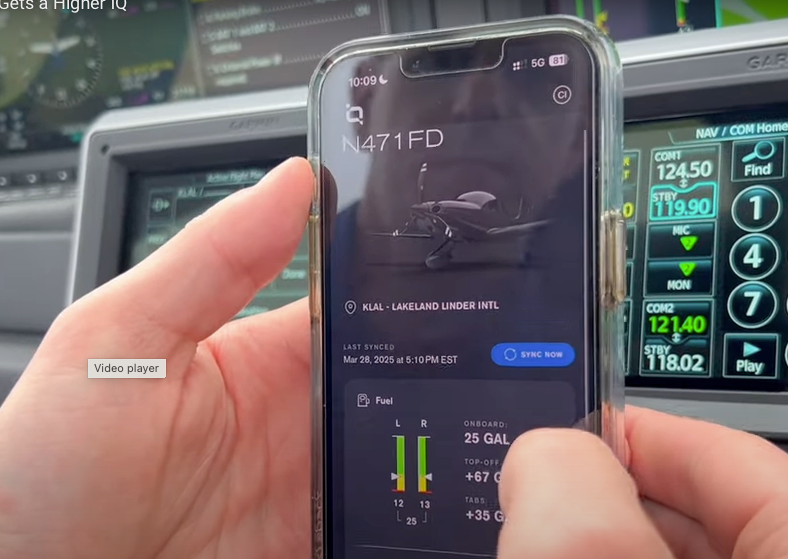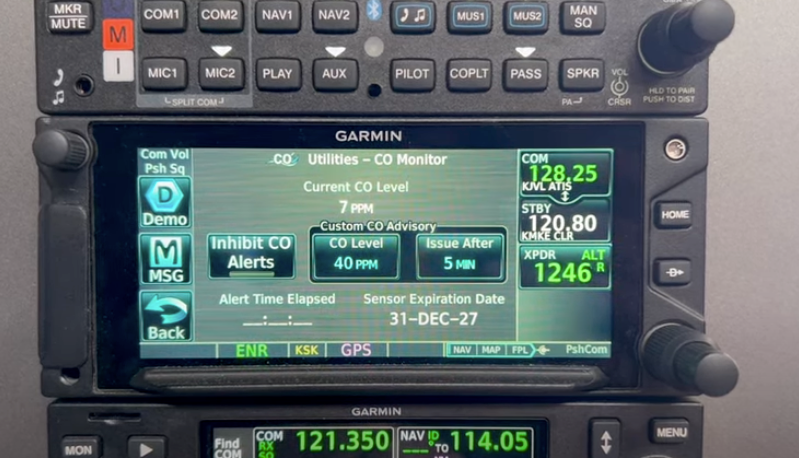Air Traffic Awareness
My career in aviation started in 2006, when I earned my private pilot certificate flying in some of the most congested airspace in the world. Today, I fly mainly Cessnas,…

This admittedly dated view from the control tower at the Manassas (Va.) Regional Airport/Harry P. Davis Field highlights the scope of a controller’s job. They’re responsible for almost everything that moves on the ground and in the air, plus coordination with controllers at other facilities nearby.
My career in aviation started in 2006, when I earned my private pilot certificate flying in some of the most congested airspace in the world. Today, I fly mainly Cessnas, but over the years have logged time in Pipers, Diamonds and other aircraft types. My passion for aviation took me to the point where the FAA accepted me as a trainee and I started a career as an air traffic controller in 2014.
Tom Turner’s February 2019 article, “The Big Picture,” highlighted for me that we should find ways to continuously improve the way we operate within the National Airspace System (NAS) and one way I can help—to give back, if you will—is to try explaining to pilots more about what goes on in the towers, TRACONs and Centers throughout the U.S. It’s not mysterious or difficult to understand, but it may be different from what you have been told, or told to expect.
A Different Perspective
The typical pilot may not have the ability to ask their questions or speak their concerns to an air traffic controller, or even be able to understand what goes on with controllers on a daily basis. Having us talk fast and speak to multiple aircraft, as it seems to be all at once, to make the operation a fine choreography of movement in the sky all stems from high-quality training, patience and having a safe mindset. A busy session is determined by the volume of aircraft and the complexity in which they arrive, depart and remain in the pattern.
A perfect example is the high volume of traffic in Class B airspace—say, 60 jets an hour, arriving and departing—may have low complexity, since most of the traffic is using the same airport and enter and leave the Bravo over well-defined and published fixes. On the flip side, tower controllers in Class D airspace may experience low volume—20 aircraft an hour, perhaps—but high complexity due to many factors.
Those complicating factors can include a mix of many different aircraft types, all flying at varying speeds and in multiple directions, terrain and even adjoining airspace. Rarely are inbound VFR aircraft sequenced for arrival by a TRACON, simply because they’re not talking to ATC before nearing the Class D airspace. Situational awareness and expectations on both sides of the mic determine how flights are handled.
Come In, Get Down
It may sound odd, but to me one of the most rewarding aspects of being a controller is the fun I have organizing the clutter of aircraft coming at my airport from all directions, just waiting to test my skills each and every day. The amount and variety of different general aviation aircraft always make it challenging. That said, there are a few good habits pilots may want to adopt to enhance awareness and to alleviate biased expectations.
First, before your initial call-up, listen to the complete automated terminal information system (ATIS) or automated weather information (AWOS/ASOS) recording. This provides weather and other pertinent information, including NOTAMs, for the airport. It’s also a legal requirement to use the runway during tower operating hours. The information in the ATIS, not just the code, must be received prior to arrival or departure at towered airports. If flight following is used, then the appropriate approach control should be advised of the receipt of information; if not, advise the tower on initial contact.
Second, listen to the frequency before keying the microphone. If it’s quiet, it might be too good to be true—especially around high-volume areas such as Southern California. Each time I fly and hear nothing upon first selecting a new frequency, a technique I use is to key the microphone twice before transmitting. This preps the controller that someone is out there not already on frequency while also checking that at least the aircraft radio will break squelch.
Third, listen to the frequency as you approach the airport and try to paint a picture of the other aircraft and how the controller is directing traffic. The idea is to establish and maintain a high level of situational awareness. To the frequent fliers, you know when I talk about the voice of annoyance, that voice that says only one word—“Blocked!”—is all too common. Sometimes, as I control traffic, while fighting the urge to face palm, I wonder if that voice comes standard on some of these aircraft. Listen to each other and listen for instructions; keep it short and simple.
Cleared...To Go!
Exiting or departing the airport seems like a simple task, but for the inexperienced or timid pilot this may present some awareness challenges. When holding short, keep the departure request short and simple. Nothing congests the frequency more than giving the controller your entire flight plan and unnecessary information. For a VFR departure from Class D airspace, a pilot should request something like “straight out,” “east departure” or “right downwind departure.” Each one of these is short and sufficient, and gets your point across to the controller. Remember, he or she is not only working you but the line forming behind you.
If you require a short diversion for sightseeing or some other reason, do not be hesitant to ask for it but do so prior to takeoff to allow the controller to apply any separation requirements needed. While departing, you also can help the controller by not lingering in the traffic pattern or at traffic pattern altitude. We know time is money; depart and go. After departure, continue to a climb to cruise altitude unless given a restriction by ATC.
Pattern Circuits
I cannot tell you how many times pilots have failed to see another aircraft less than a mile ahead. Even in Class D airspace, keep your eyes open and revert back to the basic fundamentals of your traffic scan: Keep moving your eyes in ten-degree increments as you fly to keep yourself updated of traffic and other hazards. For the speed demons out there, there’s no need to go to full power in the pattern on the downwind.
Why is speed so important? It burns precious fuel for the operation being performed, widens out the pattern, which can mean you get to fly the extended “seven-mile downwind,” and makes the pattern move much more slowly. Single-engine aircraft do just fine at around 90 knots in the pattern. Of course, twins and jets are subject to the aircraft numbers, but just because the speed limit is 200 knots in Class D airspace doesn’t mean you have to max out the limit every time. Also, respect the noise abatement procedures. Be a friendly flier and look up procedures for the particular airport you wish to fly into. If you have any questions about them, please refer to airport management.
With all this said, be proficient by taking your flying back to its basics. The high-tech electronics with bright lights and flashing colors can be a distraction of what we were really meant to do—fly the airplane. Have a good scan that works and be aware during all stages of flight. Understand that other pilots share the airspace and find ways to educate each other to have the mindset of constant and never-ending improvement.
Safe flying!
Pilot Responsibilities
The FAA’s Aeronautical Information Manual (AIM) contains a wealth of information useful to pilots when trying to understand the controller’s role in the ATC system. Some excerpts from the AIM’s discussion of a pilot’s responsibilities when working with ATC include:
Record Your Clearance
Especially when conducting IFR operations—but it’s also a good idea when VFR—make a written record of your clearance. ATC may find it necessary to add conditions and expects you to know the content of previous clearances.
Read It Back
Pilots of airborne aircraft should read back those parts of ATC clearances and instructions containing altitude assignments, vectors or runway assignments. Reading back the information helps reduce communications errors—and pilot deviations. Include the aircraft’s identification in all readbacks and acknowledgments. Initial readback of a taxi, departure or landing clearance should include the runway assignment, including left, right, center, etc., if applicable.
Accept It Or Refuse It
A controller can’t know a pilot’s skill level, nor the flight conditions he or she is facing, nor the aircraft’s limitations. Thus, it’s the pilot’s responsibility to determine if a clearance can be accepted. If it can’t, advise the controller of what parts of the clearance are unacceptable and offer an alternative.
– Jeb Burnside
ADS-B Traffic And Pilot Responsibilities
- ADS-B In’s traffic information system-broadcast (TIS-B) provides proximity warning only “to assist the pilot in the visual acquisition of intruder aircraft,” according to the Aeronautical Information Manual (AIM). No avoidance maneuvers are recommended, provided or authorized “as a direct result of a TIS-B intruder display or TIS-B alert. It is intended for use by aircraft in which TCAS is not required.”
- TIS-B does not change the pilot’s basic authority and responsibility to ensure a safe flight (i.e., not colliding with another aircraft).
- TIS-B also does not respond to aircraft which are not transponder equipped, aircraft with a transponder failure, or aircraft out of radar coverage. As such, relying on TIS-B alone does not ensure safe separation in every case.
- According to the AIM, “no air traffic service nor handling is predicated on the availability of TIS equipment in the aircraft.”
- No air traffic services are predicated on an in-cockpit ADS-B display. Advising ATC you have traffic in sight requires seeing an aircraft out the window, not on the cockpit display.
– Jeb Burnside
Eric Lyn is a private pilot who works as an air traffic controller in Southern California.
This article originally appeared in the April 2019 issue of Aviation Safety magazine.
For more great content like this, subscribe to Aviation Safety!






